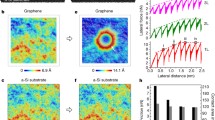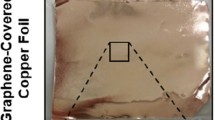Abstract
In this study, the lubricity of perfect and defective graphene on the gold substrate (Au (111)) has been investigated by using molecular dynamics simulations. The influence of surface morphology as well as the Stone-Wales (SW) defects concentration on the friction of graphene on the gold surface is explored. The SW defects in the range of 0–2.55% are randomly distributed into the graphene. Furthermore, the self-affine fractal method is employed to generate realistic rough surfaces. The effect of the external force, F E , in the range of 0.25−1.0 nN, on the drag coefficients is also investigated. It is shown that the friction force slightly depends on the sliding velocity for all systems. We show that by increasing the defect concentration, the lubricity of graphene nano-sheet slightly decreases. Moreover, it is shown that the friction is almost insensitive to the roughness degree, within the range studied. Both of these effects can be rationalized through variations in the real atomic contact area.

By increasing the SW defect concentration of the graphene, the shape of the deformation is different from a sine wave profile, the real contact area, and the friction increases.









Similar content being viewed by others
References
Buckley DH, Brainard WA (1975) Friction and wear of metals in contact with pyrolytic graphite. Carbon 13:501–508
Ruan JA (1994) Frictional behavior of highly oriented pyrolytic graphite. J Appl Phys 76:8117–8120
Dienwiebel M, Verhoeven GS, Pradeep N, Frenken JWM, Heimberg JA, Zandbergen HM (2004) Superlubricity of graphite. Phys Rev Lett 92:126101
Kwon S, Ko JH, Jeon KJ, Kim YH, Park JY (2012) Enhanced nanoscale friction on fluorinated graphene. Nano Lett 12:6043–6048
Ye Z, Tang C, Dong Y, Martini A (2012) Role of wrinkle height in friction variation with number of graphene layers. J Appl Phys 112:116102
Filleter T, McChesney JL, Bostwick A, Rotenberg E, Emtsev KV, Seyller T, Horn K, Bennewitz R (2009) Friction and dissipation in epitaxial graphene films. Phys Rev Lett 102:086102
Deng Z, Klimov NN, Solares SD, Li T, Xu H, Cannara RJ (2012) Nanoscale interfacial friction and adhesion on supported versus suspended monolayer and multilayer graphene. Langmuir 29:235–243
Xu L, Ma TB, Hu YZ, Wang H (2011) Vanishing stick–slip friction in few-layer graphenes: the thickness effect. Nanotechnology 22:285708
Berman D, Erdemir A, Sumant AV (2014) Graphene: a new emerging lubricant. Mater Today 17:31–42
Berman D, Erdemir A, Sumant AV (2013) Few layer graphene to reduce wear and friction on sliding steel surfaces. Carbon 54:454–459
Berman D, Erdemir A, Sumant AV (2013) Reduced wear and friction enabled by graphene layers on sliding steel surfaces in dry nitrogen. Carbon 59:167–175
Berman D, Deshmukh SA, Sankaranarayanan SKRS, Erdemir A, Sumant AV (2015) Macroscale superlubricity enabled by graphene nanoscroll formation. Science 348:1118
Liu Z, Yang J, Grey F, Liu JZ, Liu Y, Wang Y, Yang Y, Cheng Y, Zheng Q (2012) Observation of microscale superlubricity in graphite. Phys Rev Lett 108:205503
Lodge MS, Tang C, Blue BT, Hubbard WA, Martini A, Dawson BD, Ishigami M (2016) Lubricity of gold nanocrystals on graphene measured using quartz crystal microbalance. Sci Rep 6:31837
Dong Y, Wu X, Martini A (2013) Atomic roughness enhanced friction on hydrogenated graphene. Nanotechnology 24:375701
Ko JH, Kwon S, Byun IS, Choi JS, Park BH, Kim YH, Park JY (2013) Nanotribological properties of fluorinated, hydrogenated, and oxidized graphenes. Tribol Lett 50:137–144
Smolyanitsky A, Killgore JP, Tewary VK (2012) Effect of elastic deformation on frictional properties of few-layer graphene. Phys Rev B 85:035412
Liu P, Zhang YW (2011) A theoretical analysis of frictional and defect characteristics of graphene probed by a capped single-walled carbon nanotube. Carbon 49:3687–3697
Smolyanitsky A, Killgore JP (2012) Anomalous friction in suspended graphene. Phys Rev B 86:125432
Khomenko AV, Prodanov NV, Persson BNJ (2013) Atomistic modelling of friction of cu and au nanoparticles adsorbed on graphene. Cond Matt Phys 16:33401
Ye Z, Egberts P, Han GH, Johnson ATC, Carpick RW, Martini A (2016) Load-dependent friction hysteresis on Graphene. ACS Nano 10:5161–5168
Zhang Q, Diao D, Kubo M (2015) Nanoscratching of multi-layer graphene by molecular dynamics simulations. Tribol Int 88:85–88
Dietzel D, Feldmann M, Schwarz UD, Fuchs H, Schirmeisen A (2013) Scaling Laws of structural lubricity. Phys Rev Lett 111:235502
Cihan E, Ipek SI, Durgun E, Baykara MZ (2016) Structural lubricity under ambient conditions. Nat Commun 7:12055
Ye Z, Balkanci A, Martini A, Baykara MZ (2017) Effect of roughness on the layer-dependent friction of few-layer graphene. Phys Rev B 96:6
Kawai S, Benassi A, Gnecco E, Söde H, Pawlak R, Feng X, Müllen K, Passerone D, Pignedoli CA, Ruffieux P, Fasel R, Meyer E (2016) Superlubricity of graphene nanoribbons on gold surfaces. Science 351:957–961
Xiao JR, Staniszewski J, Jr JWG (2009) Fracture and progressive failure of defective graphene sheets and carbon nanotubes. Compos Struct 88:602–609
Fan BB, Yang XB, Zhang R (2010) Anisotropic mechanical properties and stone–Wales defects in graphene monolayer: a theoretical study. Phys Lett A 374:2781–2784
Xiaoa JR, Staniszewskia J, Gillespie JW Jr (2010) Tensile behaviors of graphene sheets and carbon nanotubes with multiple stone–Wales defects. Mater Sci Eng A 527:715–723
Lherbier A, Dubois SMM, Declerck X, Roche S (2011) Two-dimensional Graphene with structural defects: elastic mean free path, minimum conductivity, and Anderson transition. Phys Rev Lett 106:046803
Ansari R, Ajori S, Motevalli B (2012) Mechanical properties of defective single-layered graphene sheets via molecular dynamics simulation. Superlattice Microst 51:274–289
Jing N, Xue Q, Ling C, Shan M, Zhang T, Zhoub X, Jiao Z (2012) Effect of defects on Young’s modulus of graphene sheets: a molecular dynamics simulation. RSC Adv 2:9124–9129
Neek-Amal M, Peeters FM (2012) Effect of grain boundary on the buckling of graphene nanoribbons. Appl. Phys Lett 100:101905
Baimova JA, Bo L, Dmitriev SV, Zhou K, Nazarov AA (2013) Effect of stone-thrower-Wales defect on structural stability of graphene at zero and finite temperatures. EPL103:46001
Lehmann T, Ryndyk DA, Cuniberti G (2013) Combined effect of strain and defects on the conductance of graphene nanoribbons. Phys Rev B 88:125420
Wang S-P, Guo J-G, Zhou L-J (2013) Influence of stone–Wales defects on elastic properties of graphene nanofilms. Phys E 48:29–35
Kotakoski J, Eder FR, Meyer JC (2014) Atomic structure and energetics of large vacancies in graphene. Phys Rev B 89:201406(R)
Partovi-Azar P, Jand SP, Namiranian A, Rafii-Tabar H (2013) Electronic features induced by stone-Wales defects in zigzag and chiral carbon nanotubes. Comput Mater Sci 29:82–86
Sun YJ, Ma F, Ma DY, Xu KW, Chu PK (2012) Stress-induced annihilation of stone–Wales defects in graphene nanoribbons. J Phys D Appl Phys 45:305303
Rodrigues JNB, PAD G, NFG R, Ribeiro RM, JMBLd S, NMR P (2011) Zigzag graphene nanoribbon edge reconstruction with stone-Wales defects. Phys Rev B 84:155435
Lusk MT, Wu DT, Carr LD (2010) Graphene Nanoengineering and the inverse-stone-thrower-Wales defect. Phys Rev B 81:155444
Ma J, Alfè D, Michaelides A, Wang E (2009) Stone-Wales defects in graphene and other planar sp2-bonded materials. Phys Rev B 80:033407
Wang C, Y-h D (2013) Catalytically healing the stone–Wales defects in graphene by carbon adatoms. J Mater Chem A 1:1885–1891
He L, Guo S, Lei J, Sha Z, Liu Z (2014) The effect of stone–thrower–Wales defects on mechanical properties of graphene sheets – a molecular dynamics study. Carbon 75:124–132
Ebrahimi S (2015) Influence of stone–Wales defects orientations on stability of graphene nanoribbons under a uniaxial compression strain. Solid State Commun 220:17–20
Ewen JP, Restrepo SE, Morgan N, Dini D (2017) Nonequilibrium molecular dynamics simulations of stearic acid adsorbed on iron surfaces with nanoscale roughness. Tribol Int 107:264–273
Zheng X, Zhu HT, Tieu AK, Kosasih B (2014) Roughness and lubricant effect on 3D atomic asperity contact. Tribol Lett 53:215–223
Spijker P, Anciaux G, Molinari JF (2011) Dry sliding contact between rough surfaces at the atomistic scale. Tribol Lett 44:279–285
Friedrichs W, Ohler B, Langel W, Montiand S, Koppen S (2011) Adsorption of collagen Nanofibrils on rough TiO2:a molecular dynamics study. Adv Eng Mater 13:B334–B342
Yang C, Tartaglino U, Persson BNJ (2006) A multiscale molecular dynamics approach to contact mechanics. Eur Phys J E 19:47–58
Persson BNJ (2001) Theory of rubber friction and contact mechanics. J Chem Phys 115:3840–3861
Makse H, Havlin S, Schwartz M, Stanley HE (1996) Method for generating long-range correlations for large systems. Phys Rev E 53:5445–5449
Ebrahimi S, Ghafoori-Tabrizi K, Rafii-Tabar H (2013) Molecular dynamics simulation of the adhesive behavior of collagen on smooth and randomly rough TiO2 and Al2O3 surfaces. Comput Mater Sci 71:172–178
Humphrey W, Dalke A, Schulten K (1996) VMD: visual molecular dynamics. J Mol Graph 14:33–38
Stuart SJ, Tutein AB, Harrison JA (2000) A reactive potential for hydrocarbons with intermolecular interactions. J Chem Phys 112:6472–6486
Foiles SM, Baskes MI, Daw MS (1986) Embedded-atom-method functions for the Fcc metals cu, Ag, au, Ni, Pd, Pt, and their alloys. Phys Rev B 33:7983–7991
Guerra R, Tartaglino U, Vanossi A, Tosatti E (2010) Ballistic nanofriction. Nat. Mater. 9:634–637
Pilmpton S (1995) Fast parallel algorithms for short-range molecular dynamics. J. Comput. Phys. 117:1–19
Hoover WG (1985) Canonical dynamics: equilibrium phase-space distributions. Phys Rev A 31:1695–1697
Allen MP, Tildesley DJ (1986) Computer simulation of liquids. Oxford University Press, New York
Krim J (1996) Atomic-scale origins of friction. Langmuir 12:4564–4566
Bowden FP, Tabor D (1964) The friction and lubrication of solids. Oxford University Press, Oxford
Yifei M, Kevin TT, Szlufarska I (2009) Friction laws at the nanoscale. Nature 457:1116–1119
Yifei M, Szlufarska I (2010) Roughness picture of friction in dry nanoscale contacts. Phys Rev B 81:035405
Gnecco E, Meyer E (2007) Fundamentals of friction and wear on the Nanoscale. Springer, Berlin
Ritter C, Heyde M, Stegemann B, Rademann K, Schwarz UD (2005) Contact-area dependence of frictional forces: moving adsorbed antimony nanoparticles. Phys Rev B 71:085405
Dietzel D, Ritter C, Mönninghoff T, Fuchs H, Schirmeisen A, Schwarz UD (2008) Frictional duality observed during nanoparticle sliding. Phys Rev Lett 101:125505
Dietzel D, Feldmann M, Herding C, Schwarz UD, Schirmeisen A (2010) Quantifying pathways and friction of nanoparticles during controlled manipulation by contact-mode atomic force microscopy. Tribol Lett 39:273–281
Dietzel D, Mönninghoff T, Herding C, Feldmann M, Fuchs H, Stegemann B, Ritter C, Schwarz UD, Schirmeisen A (2010) Frictional duality of metallic nanoparticles: influence of particle morphology, orientation, and air exposure. Phys Rev B 82:035401
Author information
Authors and Affiliations
Corresponding author
Rights and permissions
About this article
Cite this article
Ebrahimi, S. The effect of Stone-Wales defects and roughness degree on the lubricity of graphene on gold surfaces. J Mol Model 24, 80 (2018). https://doi.org/10.1007/s00894-018-3621-z
Received:
Accepted:
Published:
DOI: https://doi.org/10.1007/s00894-018-3621-z




